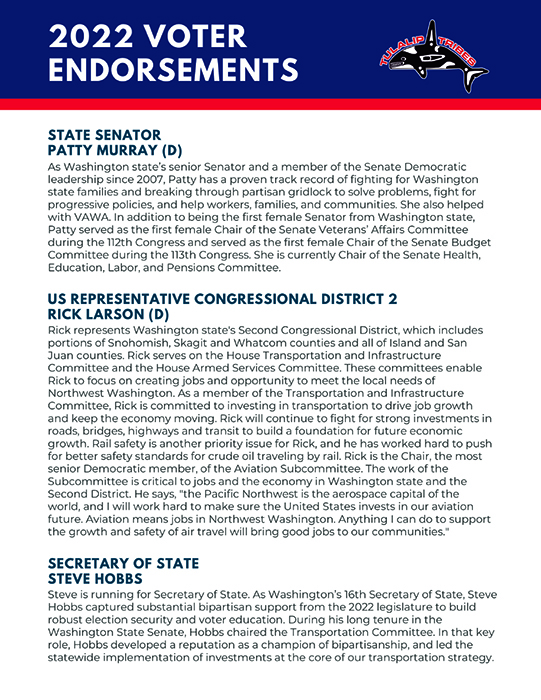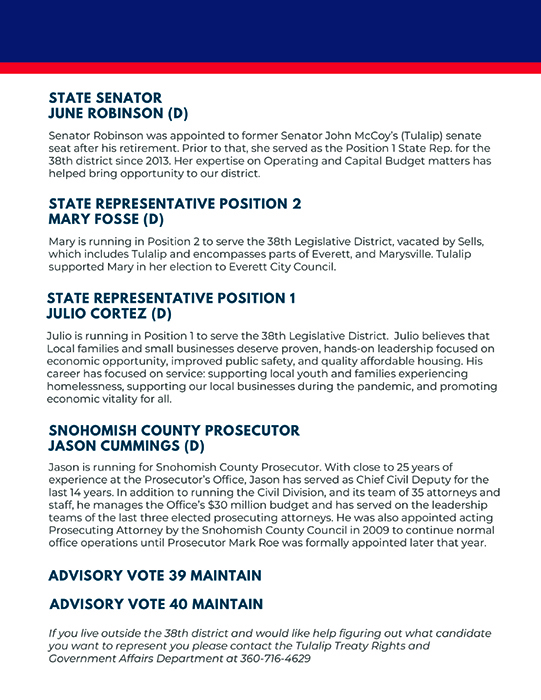Please use the following link to download the November 5, 2022 issue of the syəcəb
Raising Hands celebrates $7.2 million in Tulalip Cares charitable giving
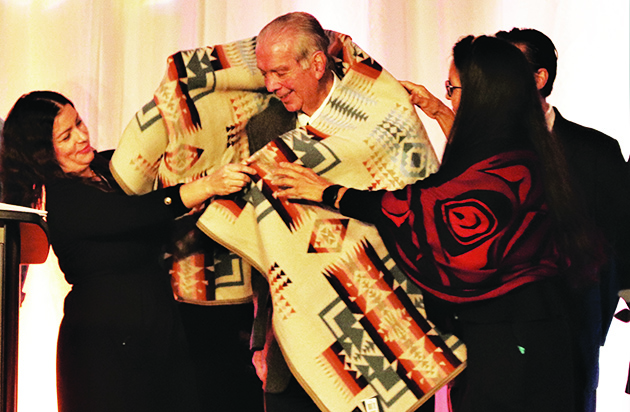
Mytyl Hernandez
By Micheal Rios, Tulalip News
During the evening of Saturday, October 29th, the Tulalip Tribes recognized and gave thanks to more than 375 Washington-based nonprofits and community groups who contributed to a sustainable and healthy community for all.
The typically annual Raising Hands celebration went on a temporary hiatus during the coronavirus pandemic before making its much anticipated 2022 return. Held in the Tulalip Resort Casino’s Orca Ballroom, the always stylish space hosted hundreds of representatives of these high-impacting organizations that came together to create an atmosphere of appreciation.
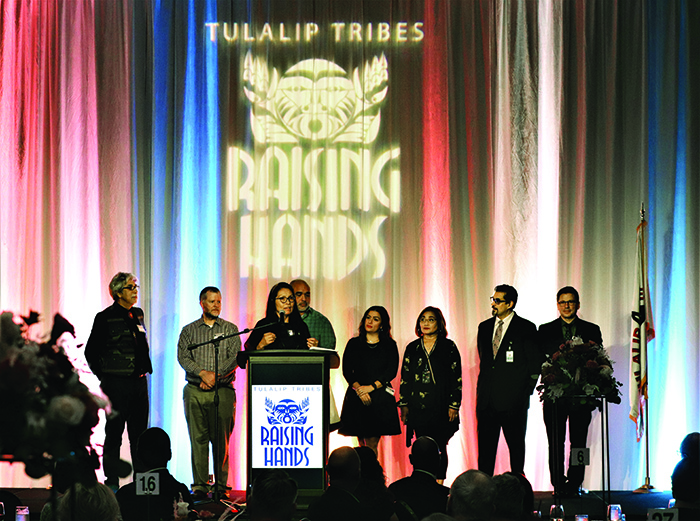
“In the Tulalip tradition, we raise our hands to show appreciation to the numerous organizations whose good works help to make our communities strong,” opened event emcee and board of director, Mel Sheldon. “This evening is an opportunity for Tulalip Tribes to honor and show respect to all the hard work each organization has contributed to the progress of all our communities.
“We are here to honor all 378 unique charities that Tulalip Cares has supported over the last year,” he continued. “During Covid, as we all hunkered down in our homes, many of you were out on the front lines working to help those in dire straits. Your work does not go unnoticed. Tulalip takes great pride in pulling together with all our community organizations, charities and members to support and provide guidance through this healing process.”
The exciting return of Raising Hands was bolstered by the significant community achievement stimulated by an astounding $7.2 million in tribal support to more than 375 nonprofits and community groups. Since 1992, the Tulalip Tribes charitable giving program has donated over $116 million in support to the community and, indirectly, to their own membership by supporting regional efforts to improve education, health and human services, cultural preservation, public services, and the environment.
But the Raising Hands event isn’t all about dollars and cents. It’s also a highly coordinated celebration where our community’s change makers are given a chance to share their plans for the future and learn how other like-minded charities are striving to make a difference. This is an invaluable benefit for organizations who can sometimes struggle to get their message broadcast to larger audiences.
During the 2022 rendition of Raising Hands, six standout nonprofits received special recognition for their exceptional creativity and effectiveness. Raven Rock Ranch, Museum of Glass, Sherwood Community Services, NOAH Center, Salmon Defense, and Innovative Services Northwest were each highlighted for their innovative work serving local communities.

We transfer in and adopt out about 4,000 to 4,500 animals every year. We just love to see those animals go from a scenario where they may have faced a completely difference outcome to end up living their best life with their new family. It’s so amazing to hear the squeals of excitement from kids who are getting a kitten or puppy. These animals bring so much joy to the lives of their adopters.”
– Stacie Ventura, NOAH Center executive director
“When you see people coming together to have these amazing, positive conversations, that is when we know we are helping make a difference,” asserted Marilyn Sheldon, manager of Tulalip Tribes Charitable Fund. “We try to show respect and honor these charities that give so much of themselves for this community. We want them to feel like the red carpet got laid out just for them.
“Each year, as soon as the event is over, we ask ourselves how we can help make the next one even better,” she continued. “Giving people the opportunity to work together is priceless. We are so fortunate to be able to work with these amazing organizations throughout Washington State that do so much good in our communities.”
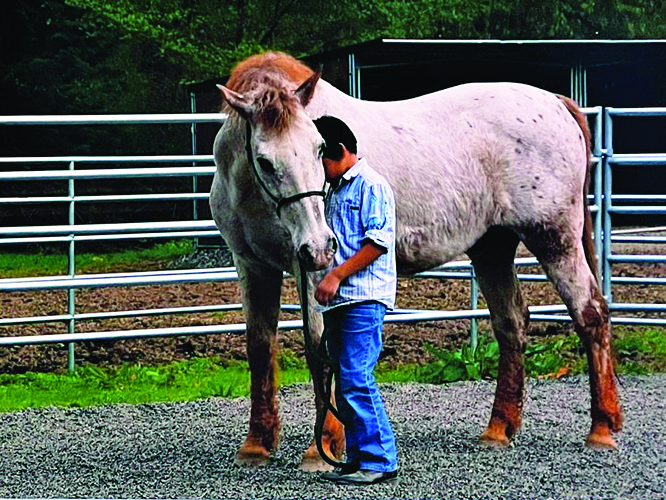
In order to lead a horse around, you must be confident in where you are going. Horses really depend on their handlers stepping up and taking care of them, and our kids can really feel that connection. When kids come here they are responsible for taking care of their horse. Offering something to another living being is an important piece of feeling valuable and worthy.”
– Sandy Matts, executive director of Raven Rock Ranch
The Indian Gaming Regulatory Act (IGRA) of 1988 allows tribes to conduct certain types of gaming if they enter into a gaming compact with the state. Tulalip’s tribal-state gaming compact, like most, includes a provision to donate a percentage of gaming earnings to organizations impacted by gaming, as well as other charitable organizations. From this provision the Tulalip Tribes Charitable Fund was created.
The Charitable Fund, also known as Tulalip Cares, provides the opportunity for a sustainable and healthy community for all. The Tulalip Tribes strives to work together with the community to give benefits back to others to help build stronger connections to local neighborhoods. That’s why, in Tulalip, it is tradition to ‘raise our hands’ to applaud and give thanks to the numerous organizations in our region that strive to create a better world through positive action.
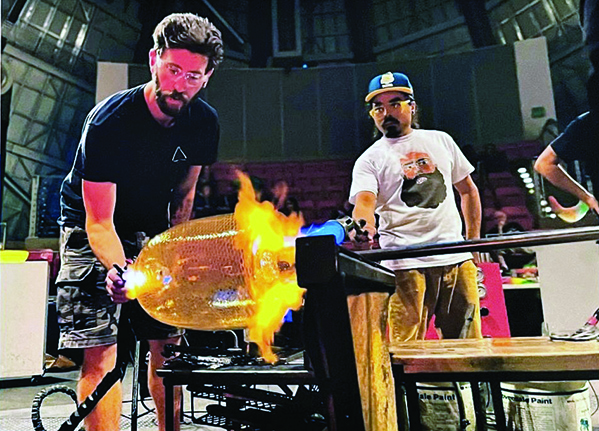
It’s a place where you can see first-hand art being made. You see the struggles. You see how an idea comes to life. Shaping the future of glass is our vision and I feel like we do it every day. And maybe even more important than that, I think we are helping to shape community and the future of the people who come here and experience the beauty of glass art.”
– Debbie Lenk, Museum of Glass executive director
Nonprofits and community groups are encouraged to apply for quarterly awards through the Tulalip Cares program. For more information, visit the Tulalip Tribes Charitable Funds website at www.TulalipCares.org
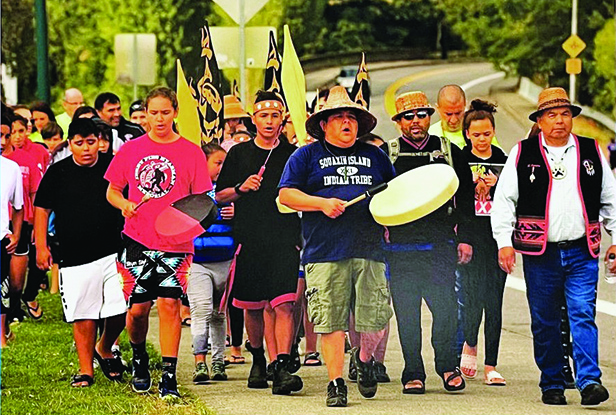
When the tribal governments are fighting for their treaty rights they are fighting for clean water, they are fighting for salmon, they are fighting for clean air, they are fighting for a healthy environment. Treaty rights don’t just protect our tribal people, they protect all our people. We want people to not fear the tribes and their treaty rights, but embrace them for the gems that they are because they protect and enhance our health and our quality of life.”
– Peggen Frank, executive director of Salmon Defense
Beading as Healing
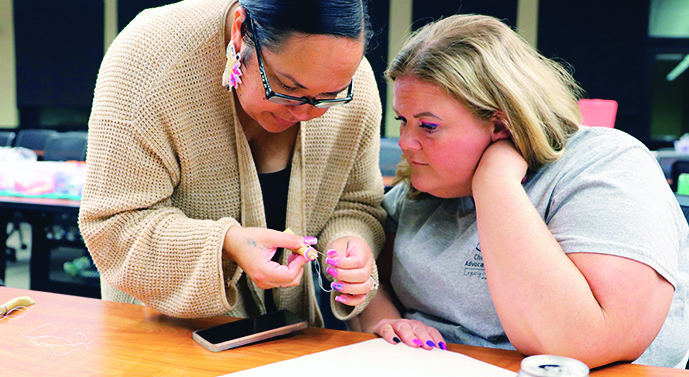
By Kalvin Valdillez, Tulalip News
“As women, there are a lot of things that we go through in our lives, and the one thing I always had was beading,” said Tulalip artist, Winona Shopbell-Fryberg. “It is healing. You space everything out and you’re focused on the work. To bead and to continue to do these things, you have to have good feelings and a clear mind. If not, you have to lay it down. When you’re expressing all of that, your emotions come out. There’s a lot of thinking and patience that goes into it and I think that’s a part of the healing process.”
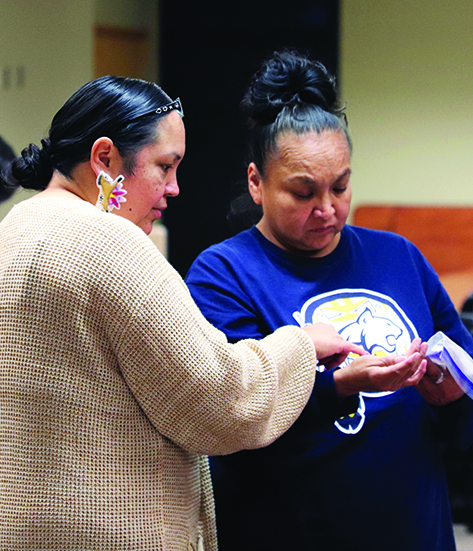
Fifteen local women showed up in support of domestic violence (DV) survivors during the Legacy of Healing’s (LOH) final event for the month on the evening of October 25. LOH hosted several events in recognition of National DV Awareness Month and each event had great turnouts, averaging twenty participants for each gathering.
DV Awareness Month closed with the Beading as Healing Class. What made this class special was that it was instructed by a Tulalip tribal member whose beautiful beadwork and regalia are well-known not only amongst the sduhubš territory, but also on the powwow trail which her family regularly participates in.
Winona explained, “I’ve been beading since I was 16 – self-taught. One day I was like ‘Dad, take me to the bead store. I want to learn how to bead’. I just kind of figured it out from there. I’ve had some tips along the way, but it’s been 30 years of beading for me. It’s therapeutic; just to get to know your creative self is amazing. My husband and I made most of our kids’ beadwork. When we go to powwows and see it out there, it’s like ‘wow, I really did that’. It’s just beautiful to see your thoughts and vision come to life through that work. I’ve been beading leggings, moccasins, everything for powwows, earrings, whatever. For me it helps a lot in healing.”
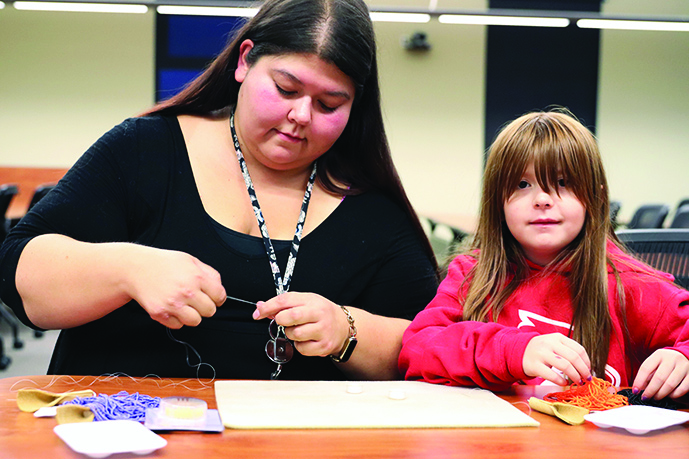
At the center of room 162 were numerous containers filled with beads varying in size and color. Once the ladies selected their beads and received their needle and thread, Winona taught the class how to create beaded keychains.
The two-and-a-half-hour class was relatively quiet as the students took the opportunity to go inward and spend some time with their thoughts while they worked on their keychains. That was ultimately the LOH’s goal behind the class, but there was plenty of laughter and a number of stories shared throughout the class as well.
“I started a beaded keychain today, I’ve always wanted to make one of these” expressed tribal member, Veronica Iukes. “I haven’t beaded in a long time, so it was cool to get back out. You get in the zone and start thinking. Doing it bead by bead makes it more meaningful. Each bead to me represents something that I was thinking about. If you’re having a stressful day, beading helps smooth things out.”
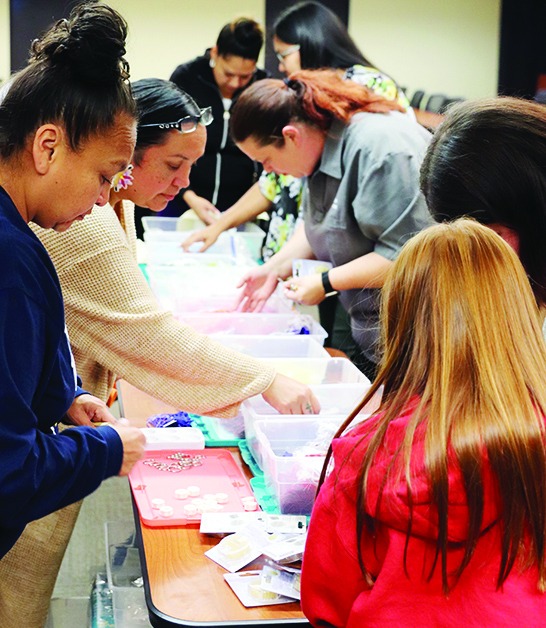
The ladies put a good-sized dent in their personal beading projects and before they knew it, it was time to pack up their beads for the night. Winona encouraged them to complete their keychains at home where they can continue healing through a traditional Indigenous artform. Before heading out, many of the participants stopped and chatted with the LOH team, thanking them for creating a safe space where they could learn about DV and gather resources throughout the awareness month.
“Making the keychain today was really calming and peaceful,” said Kelly Waibel, Victims Services Coordinator for the Tulalip Police Department. “The beading helped me feel more centered and grounded. These events provided the people a space to learn during DV Awareness Month. LOH does amazing work, they are here for the victims and survivors of DV, and they support our community. It’s nice that they are able to bring the community together, so the people know they are not alone.”
If you or anybody you know is experiencing an abusive relationship, please do not hesitate to call the LOH at (360) 716-4100 for assistance. And if you are in a crisis or an emergency situation, the LOH provided a list of three additional hotline numbers that you can utilize during your time of need:
- The National Domestic Violence Hotline 1-800-799-SAFE (7233)
- Strong Hearts Native Helpline: 1-844-762-8483
- Domestic Violence Services of Snohomish County 425-25-ABUSE (22873)
October 29, 2022 syəcəb
Please use the following link to download the October 29, 2022 issue of the syəcəb
As seasons change, Club doors remain open
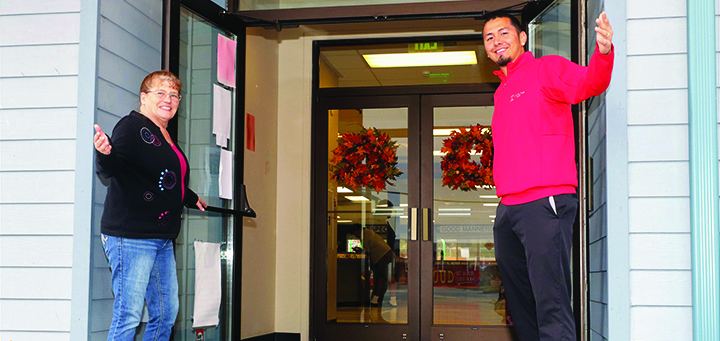
By Micheal Rios, Tulalip News
The season has quickly changed here in the Pacific Northwest. Only a matter of days ago, on October 17 to be exact, we had the warmest October day in 45 years when the temperature soared to 89 degrees. Now though, a quick glance at the local weather forecast and we see only daily highs in the mid-50s and overnight lows in the 40s. Plus, a near constant barrage of much anticipated rainfall every single day.
With the wet and cold season upon us, many community families are quickly having to adjust and figure out ways to keep their kids healthy and active while remaining warm and dry indoors. Well, the leadership of our Tulalip Boys & Girls Club want to remind parents and guardians of school aged youth that ‘the Club’ is an ideal option.
The Club is open for new and returning members, and staff eagerly await that high-spirited energy to fill their complex once again.
“We can’t wait to have all our kids back again experiencing the large variety of fun and safe programs we offer. Whether that be activities like coloring or building with LEGOs for the real young kids who are learning their shapes and colors, playing bumper pool, or standard pool for the teenagers. These are simple, yet effective, activities that develop hand-eye coordination. Then there’s basketball and volleyball in the gymnasium that promote physical education and teamwork,” said office manager Diane Prouty.

During her 23 years of dedicated Boys & Girls Club service she’s proudly earned the title ‘Grandma Diane’ by the multiple generations of Tulalip youngsters who have called the Club a home away from home.
“Something we’ve always been proud to say is we keep our kids well fed with hot, nutritious meals,” she continued. “Since we’ve been back to our normal routine of cooking and serving a breakfast for the kids before school and late lunch after school, plus a snack or two, the kids have really been swamping back in. We have our own on-site nutritionist and cook, her name is Ariana, and she does an amazing job of whipping up tasty meals that our kids devour.
“We’re also proud to be part of the T.R.A.I.L. to diabetes prevention program, which guides our meal and snack making. This is why it was a big deal for us to go close to sugar-free by doing away with soda and high fructose juices. Instead we make fruit-infused water that the kids get a real woot out of. They drink barrels and barrels of water every day.”
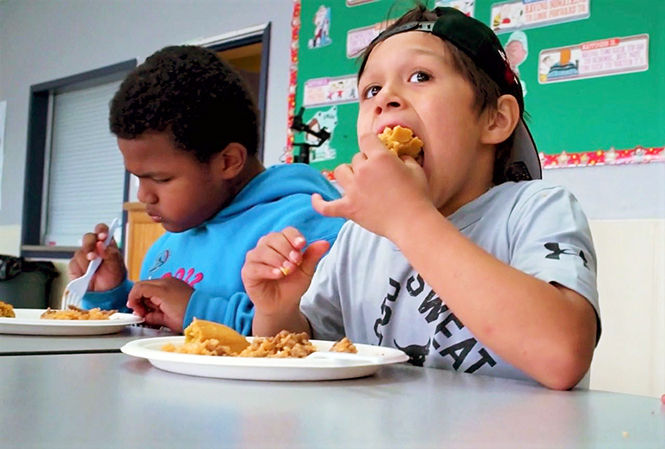
Keeping children fed with freshly prepared meals and nutritious snacks is something that’s always separated the Tulalip’s Club from thousands of other Boys & Girls Clubs in the country. Those meals are especially important when it comes to the ever-growing minds and bodies of our youth who need all the vitamins, minerals, and proteins they can get.
Then there’s the 4000-square-foot, multimedia filled expansion that was added to the Club right before Covid hit. This tech hub is intended for the Club’s teenage membership and offers all the digital goodies this current era of teen yearns for. There’s Xbox One gaming stations complete with 4k televisions, a dedicated high-speed internet server, and a sound system that rivals most music studios. Cyber Café functions as a self-serve snack bar. There’s even a makeshift graffiti wall available for those artsy types who can create masterpieces with just chalk and their imagination.
There are conventional games as well for those who prefer their games of skill without computer assistance, like a pool, foosball and chess. A dedicated homework area consists of several computer stations equipped with all the necessary programs to meet the modern coursework demands, while also aiming to shrink the Reservation’s homework gap.
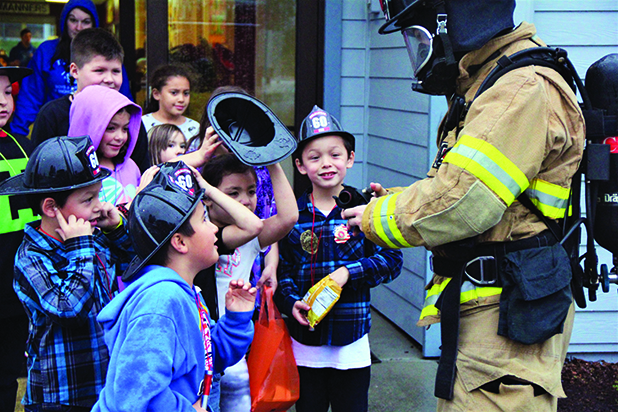
In the spirit of providing programs that promote growth through education, Club director Shawn Sanchey recently debuted ‘power hour’. The Tulalip tribal member and graduate of Heritage high school routinely shares his story of being a Club kid, including how having caring adults in the community to help guide him had a significant impact. Power hour is one example of how the 27-year-old Club director strives to pay that guidance forward.
“Power hour focuses on our kids’ education and is intended to help develop positive mental health as it relates to learning,” explained Shawn. “Instilling a work ethic and positive view on education is huge in our youth. How it works is when our kids get to the Club, they have to earn their screen time or gym time or any other recreation by completing their power hour first.
“It’s one hour, just 60-minutes, where they focus on their education. It could be completing math packets or other homework, reading a book, or could even be for the older kids to read to the younger kids or play UNO with them to help teach shapes and colors. It’s a small step that can have a big impact. We’re always talking about creating future leaders, that requires taking accountability over learning and instilling our values at a young age.
“It’s been awesome for me, personally, to witness kids go from being resistant to reading and doing school work to being excited to complete their power hour,” he added. “It’s also had a big social influence on our kids. We know that they watch and learn behavior from each other, so the more they see their peers getting excited to read to others or even form groups to review multiplication tables, it goes a long way in making a motivation difference.”
Since the new school year started, the average attendance at Tulalip’s Boys and Girls Club has increased to about 125 kids per day. With the increased capacity of the Teen Center expansion and recently added staff, the Club is able to serve 300 kids a day.
Over the next month or so, special events and activities are being planned so the kids can celebrate Halloween, Veteran’s Day and Thanksgiving in a culturally appropriate way. Also, with basketball season right around the corner, there are plenty of opportunities to get eligible kids signed up so they can take to the court to get buckets.
Current Club hours are 6:00am – 7:00pm, Monday – Friday. Plus, every other Saturday for teen night. For all questions and inquiries about membership eligibility or day to day operations, please contact 360-716-3400 or email director Shawn Sanchey directly at ssanchey@bgcsc.org
Vamping up emergency preparedness for the tribe
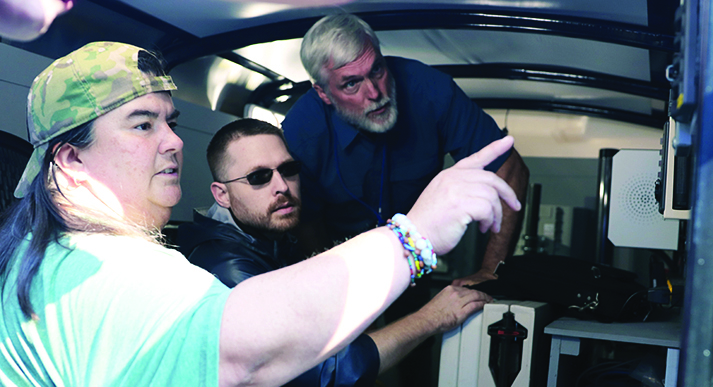
By Kalvin Valdillez, Tulalip News
A group of twenty people circled up outside of the Snohomish County Department of Emergency Management (DEM) on the afternoon of October 13. Cars, semis, and motorcycles zoomed down Washington State Route 526 and airplanes flew by overhead as the group exchanged introductions and pleasantries at the DEM, which is located at the Paine Field area of Everett. With notebooks and writing utensils in-hand, the group was comprised of several representatives of Tulalip departments who showed up ready and eager to learn about the DEM and tour its facility. Collectively, this group is officially known as the Tulalip Emergency Response Team.
“The team; we have our public works department, our utilities department, community health department, Fire department, Police department, GIS, and TDS,” explained Emergency Preparedness Coordinator, Angel Cortez. “We’re going to need more departments to assist because when something happens, there is a whole army that’s needed – boots on the ground workforce to make sure that everybody is able to respond, that we’re connecting to who we need to connect with to get resources. To get all these different departments involved is important.”
Since stepping into the position of Emergency Preparedness Coordinator, Angel has been on a mission to ensure his community is best prepared for any situation if a disaster were to strike the sduhubš homelands. Upon visiting the DEM for the first time, he found inspiration to create a similar setting on the reservation that can be readily available to assist the Tulalip people in the event of a crisis or natural disaster. Angel organized the tour of the DEM for the tribal emergency response team to give them a glimpse of the vision he has in mind for Tulalip.
Leading the tour was the Snohomish County Emergency Management Program Manager, Jarrod Dibble, who gave a detailed account of what the DEM is, how they service local communities, as well as a few examples of how they handled emergency situations in the past such as the Oso landslide and more recently, the Bolt Creek wildfire.
“We started outside today with our deployable assets,” said Jarrod while recapping the tour. “We have a couple small trailers that are solar powered that provide network capability and Wi-Fi calling – redundant capability with internet for those kinds of standalone deployable trailers. And then we looked at a couple of our other deployable vehicles that are command and control centers. One is a vehicle that can actually drive to our trailers, but act as a mobile emergency operation center (EOC). And inside is our actual EOC, where we talked about the upgrades we’ve done over the years, the lessons learned about what works well, what doesn’t work well, how we coordinate, and the room being set up to follow the instant command system structures that are standard for emergency management.”
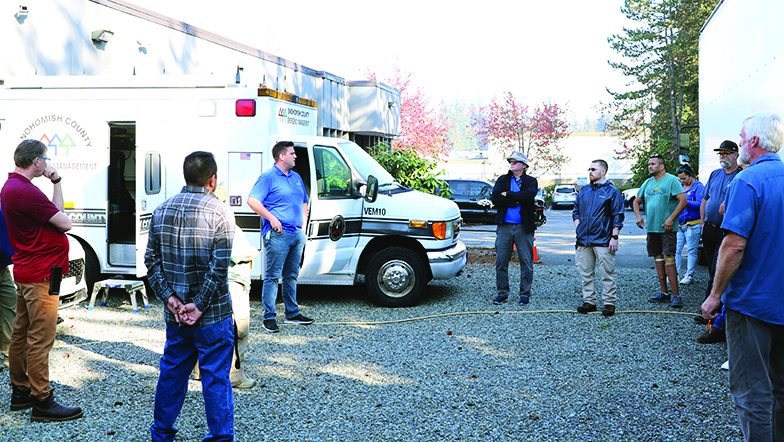
The two-hour tour was intriguing, to say the least, for the Tulalip Emergency Response Team While viewing the high-tech trailers filled with monitor screens, cables, and CB radios, the members of the Emergency Response Team shared excited glances with one another, no doubt already exchanging telepathic ideas about how to design deployable trailers for the community of Tulalip.
The highlight for many was the in-person viewing of the DEM’s EOC. Multiple computer stations are set up in a large room of the facility, which accounts for nearly half of the entire DEM. The workstations are sectioned off by departments and agencies such as public safety, planning, resourcing, and GIS. According to FEMA, “An EOC is a central command and control system responsible for carrying out the principles of emergency preparedness and emergency management, or disaster management at a strategic level during an emergency, and ensuring the continuity of operation of a company, political subdivision, or other organization. The primary function of staff in EOC’s include collecting, analyzing and sharing information, supporting resource needs and requests, including allocation and tracking, coordinating plans and determining current and future needs. And in some cases, providing coordination and policy direction.”
Jarrod explained that the Snohomish County Emergency Management and the Tulalip Tribes have an inter-local agreement (ILA) which outlines everything that the County can provide for the tribe such as planning and training, as well as the ability to respond to a disaster on Tulalip’s behalf. The Snohomish County DEM will be offering said trainings in the near future to the Tulalip Emergency Response Team and in-turn, Angel hopes to offer those trainings to the community down the line.
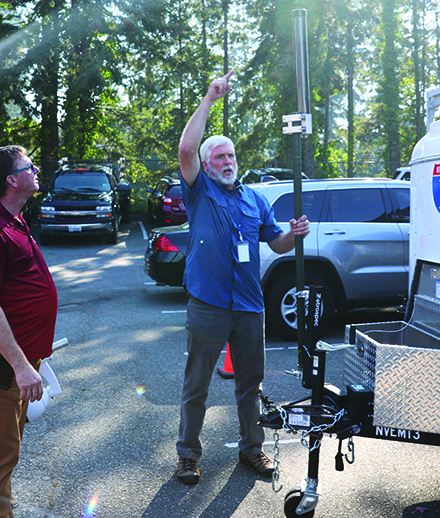
After re-establishing monthly meetings for the tribe’s emergency response team after the pandemic, Angel now hopes to build a permanent EOC at Tulalip that could be utilized during windstorms, power outages, water shortages, and during a number of incidents that require additional resources and/or medical attention. With an established EOC, the Tulalip Emergency Response Team will also have the ability to hire on volunteers and provide the necessary trainings in order for them to assist in the event of an emergency. And by training volunteers, Angel believes that this could ultimately lead to a career path for many, or at the very least beef up a few resumes.
Angel said, “I want Tulalip to be an asset, not a responsibility or liability. To be able to manage an incident without having to rely on the outside partners, I think is going to be huge for our community. But it is also going to take time and a lot of effort and planning. I would like to see Tulalip take the steps towards having our own emergency operating center, so that when a situation does happen, we’re ready to go. The ILA that we have with the county, it’s very good that we have that. But I don’t want to solely rely on that, because if it’s a big disaster, they’re not just going to come and assist Tulalip with everything, they’re going to be spread out throughout the whole county. We need to be able to handle incidents on our own, to the best of our ability.”
The Tulalip Emergency Response Team left the DEM filled with optimism, and many of its members now share Angel’s vision of bringing an EOC to Tulalip. The tour was just the first step down a long road. But after experiencing the local DEM in-person, the response team is all the more committed to ensuring the safety of the Tulalip citizenship through disaster preparedness and emergency management.
Tulalip Tribes 2022 Voter Endorsements
Indigenous film screened to raise awareness about domestic violence
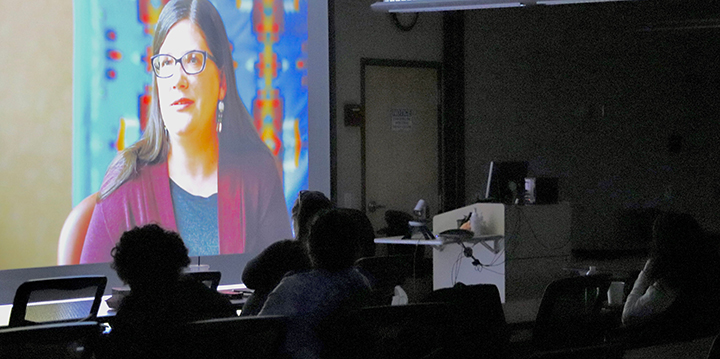
By Kalvin Valdillez, Tulalip News
The lights in room 162 of the Tulalip Administration Building were switched off on the evening of September 20. All eyes were watching a large projection screen at the front of the conference room as a movie was cast from the Panasonic overhead projector. There were over twenty ladies seated throughout the room. And although only visible by silhouette, they could not hold back some of the emotions brought on by the film, and were seen wiping tears from their eyes, shaking their heads in astonishment, and audibly gasping in shock as six Indigenous women shared their story in an 84-minute documentary titled, Sisters Rising.
The 2020 film is a moving, heartbreaking, and empowering watch that details the abuse and domestic violence (DV) that Native women face in today’s society. The film exposed the frustrating roadblock that those individuals experienced when they attempted to report the crimes committed against them and their loved ones.
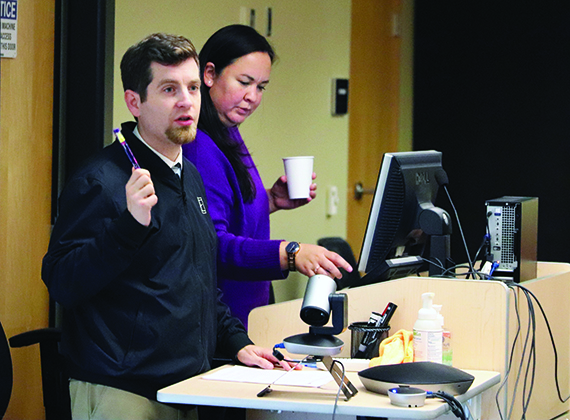
A Supreme Court ruling in the late ‘70’s ruled that tribal courts do not have the jurisdiction to try and prosecute non-tribal members who commit crimes against their membership. For decades, non-Natives targeted Native women, children and men on reservations throughout the country and got away with child abuse, sexual abuse, DV and much more, resulting from that ruling.
The women featured in Sisters Rising retold their stories and showed how survived those horrific experiences of abuse and DV. More importantly, it showcased their resilience as each of the six women went on to help their communities, whether through prevention and awareness work or taking the initiative to change legislation in their respective homelands. All of the women are making a big impact in their tribal communities.
The film’s synopsis leads with some eye-opening statistics: “Sisters Rising is a powerful feature documentary about six Native American women reclaiming personal & tribal sovereignty. Native American women are 2.5 times more likely to experience sexual assault than all other American women. 1 in 3 Native women report having been raped during her lifetime and 86% of the offenses are committed by non-Native men. These perpetrators exploit gaps in tribal jurisdictional authority and target Native women as ‘safe victims’. Their stories shine an unflinching light on righting injustice on both an individual and systemic level.”
Following the film screening, Tulalip Prosecutor Brian Kilgore was on-hand for a quick Q&A and to talk about how the film relates to the Tulalip Court and community. He shared, “The Supreme Court took away the jurisdiction of tribes to prosecute non-Indians. In 2013 we got back the ability to prosecute domestic violence crimes with Indian victims, with a couple of exceptions. One of those exceptions was there had to be a tie to this reservation. If you had people that were just passing through, we didn’t have jurisdiction. In October of this year, it was expanded again. Now we have jurisdiction over everybody.”
He continued, “This year I have gotten a felony DV referral every week, on average. It’s a lot. The other overlay here is that it’s not just jurisdiction over people. Tribes until very recently didn’t have any jurisdiction, we could only charge the not serious stuff. And what often happened is that the serious stuff got charged as not serious stuff. So, there might have been felony conduct but they still got a misdemeanor. Felony is anything greater than a year, misdemeanor is up to a year. The Tulalip Tribes had felony jurisdiction since 2012. We had two felony cases in 2015, and we had 70 this last year. It’s increasing; it’s not a good thing, right? But my sense is that there isn’t more crime, we’re just catching more of it, and we’re able to prosecute more of it. I think it is a good thing. I think the numbers we’re seeing are more realistic, and it doesn’t really represent more violence.”
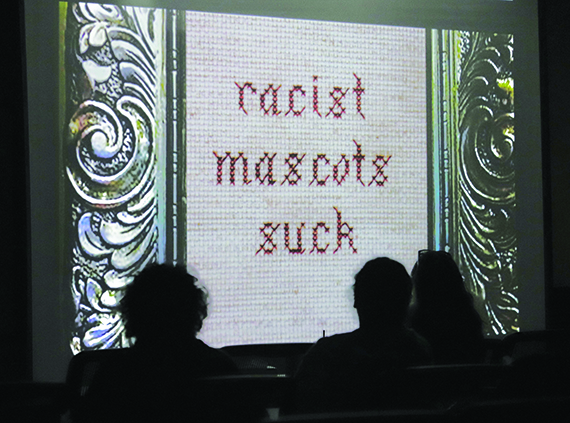
The film screening was hosted by the Tulalip Legacy of Healing (LOH) and the Child Advocacy Center (CAC) in observance of National DV Awareness Month. Throughout October, the two programs have held a number of events to help bring attention to the DV that occurs within Native America and more specifically, here at Tulalip. In addition to the Sisters Rising screening, they have also hosted a Resolving Trauma workshop with the Director/Consultant of the Midwest Trauma Services Network, Frank Grijalva MSCC, MSPH, as well as a self-defense class led by the Tulalip Police Department.
“One of the core focuses with DV Awareness Month is the importance of breaking the silence,” expressed Sydney Gilbert, CAC/LOH Coordinator and Forensic Interviewer. “If people are not talking about and it’s not coming to light, it lives in the shadow. The more we can talk about it, the more we can bring it to attention, the more we can normalize the conversation around it. We know that there’s higher rates of intimate partner violence in communities that have experienced trauma. Another focus we have for this month is addressing that trauma, and not only bringing attention to intimate partner violence, but bringing attention on how we can heal from that as a community.”
After the documentary’s credits finished rolling, Tulalip tribal member Lena Hammons, who sat attentively in the front row, expressed, “I loved that they were in front of tribal council proposing new codes to protect their women. I think that we need more people doing that, and if not go to General Council because it is a serious issue. I didn’t know there was 70 cases already this year and I’m out in the community a lot so that was kind of scary for me. I love the strong women who were standing up, helping each other and helping themselves. I’m a DV survivor myself, and had to fight for myself and my kids. It was nice to see they weren’t presenting themselves as victims, they were presenting themselves as survivors and supporters. Women need to know that they’re not alone and we need to support each other. Whether you know someone or not, if you know something is happening you need to report it.
“And for men and our women who are violators, it’s important for them to know that it won’t be tolerated. It’s not our way. It’s not traditional. It’s not cultural. It’s colonized behavior. It’s important for everybody to know that. You don’t have to tolerate DV. If you’re a perpetrator of DV, there’s help for you. Go get the help. Because we love everybody, and we don’t give up on anybody.”
If you or anybody you know is experiencing an abusive relationship, please do not hesitate to call the LOH at (360) 716-4100 for assistance. And if you are in a crisis or an emergency situation, the LOH provided a list of three additional hotline numbers that you can utilize during your time of need:
- The National Domestic Violence Hotline 1-800-799-SAFE (7233)
- Strong Hearts Native Helpline: 1-844-762-8483
- Domestic Violence Services of Snohomish County 425-25-ABUSE (22873).
Centennial Accord addresses Native concerns
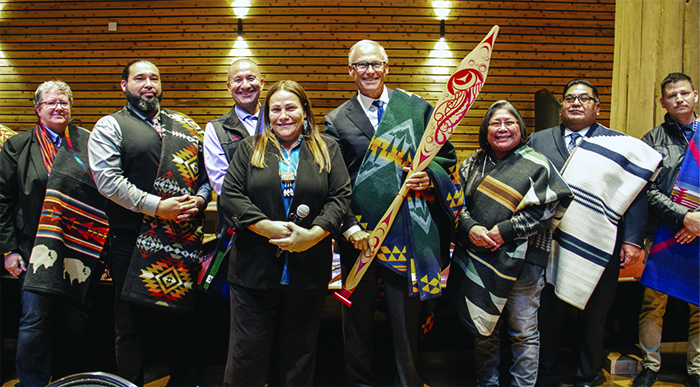
By Shaelyn Smead, Tulalip News
On October 24-25, Tulalip Tribes hosted the 33rd annual Centennial Accord at the Tulalip Resort Casino and the Tulalip Gathering Hall. Washington Tribal leaders, State legislators, Governor Jay Inslee, and numerous government agencies were in attendance to discuss policies and issues regarding tribal sovereignty, humanitarian efforts, and other tribal concerns.
The Centennial Accord was developed in 1989 by the federally recognized Indian tribes of Washington State and the State of Washington to build trust and confidence among the parties in the government-to-government relationship. Meetings like the Accord help strengthen the foundation for the future of tribes in Washington and how our people operate. Having a Native voice to discuss, change, and implement state policies significantly affects how Washington handles Native issues in the future.
Chairwoman Teri Gobin began the meeting by saying, “Thank everyone for all your efforts and being here today. My dad Stan Jones was a part of history and participated when the first Centennial Accord was passed. I remember praying that we would reach a point where our people would be treated as equals, our rights would be respected, and our sovereignty would be protected. Years of hard work have gone into this, and we are at a pivotal point in history where so many issues require us to take action now. Our ancestors are here with us and watching over us as we make these changes.”
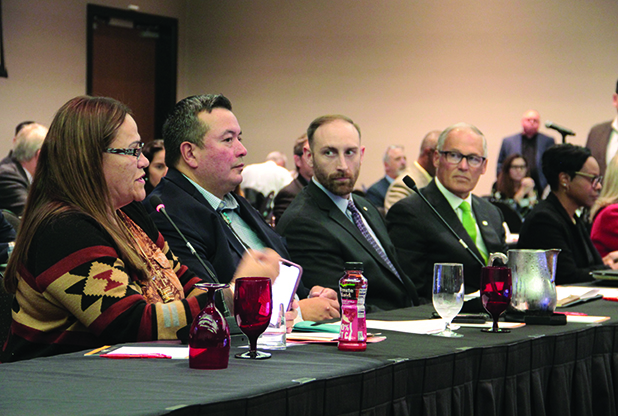
Throughout the day, the parties discussed specific issues involving education, health, the Climate Commitment Act, the HEAL Act, environmental justice, Social Services, and Natural Resources. The first day of the Accord is used to finalize details and answer concerns before presenting these agendas to the state Governor on the second day.
This year’s Centennial Accord was the first gathering that Higher Education acquired its own roundtable discussion. One of the many topics discussed was the lack of Native employee and counselor representation within colleges, funding towards Native students, and hardships that first-generation Native college students face. And though many of the public colleges are willing and able to work with tribes, establishing the foundation of these efforts is what many tribal leaders are trying to develop.
Representative Debra Lekanoff, D-Bow, was in attendance for the Accord and spoke about the actions that she is taking for Higher Education, “I’m proposing a Bill this year that provides free tuition, housing, and a stipend for food. This will apply to Native Americans of all federally recognized tribes across the nation attending (public) universities and colleges in Washington. If you are a Native from a federally recognized tribe from Montana and enroll in a university or college in Washington, then you can receive funding.”
During the Social Services meeting conversation focused on the Indian Child Welfare Act (ICWA) and the possibility of it being overturned by the Supreme Court on November 9. Ross Hunter, Secretary of the Department of Children, Youth, and Families, and Honorable Loni Greninger, Vice-Chair of the Jamestown S’Klallam Tribe, assured that they are working to prepare an argument for November 9 to preserve ICWA, and have been diligently working with other states in the US to do the same.
When speaking about the health struggles that Native people face, a State of Emergency was discussed, as Native Americans accounted for 63% of the suicide attempts in Washington in 2020. It was also noted that in 2001 the Native American mortality rate increased by 58%. To help mitigate this issue, the Substance Abuse and Mental Health Services Administration (SAMHSA) set up a 24/7 emergency hotline dedicated to mental health crises called the 988 Suicide and Crisis Lifeline. When a Native is suffering a mental health crisis, they can dial 988, explain that they are Native, and be transferred to a Native mental health and substance use disorder professional in their territory and seek specific cultural and spiritual guidance. It is a new program that SAMHSA hopes to have operational soon.
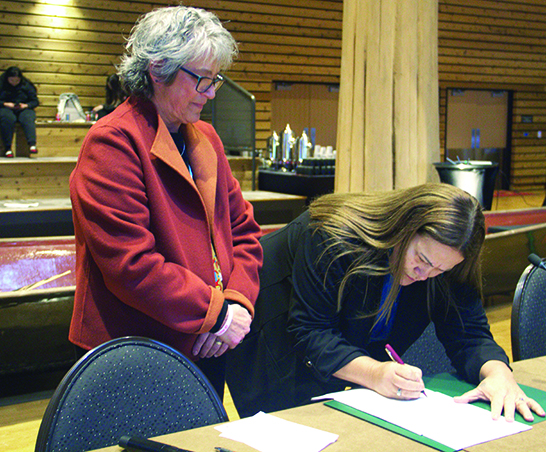
The opioid crisis was also heavily discussed at the Accord. Lummi Chairman William Jones Sr was transparent about their declaration of emergency, their struggles, and concerns about fentanyl, saying, “We keep talking about how it’s a crisis, and how devastating it is for our people, but why isn’t the government attacking this issue like they did Covid? I’m sure everyone in this room can say they have been affected by fentanyl. We’re becoming almost numb to hearing about overdoses, but we must figure out a solution and need real help from the state.”
Many other tribes shared their problems with fentanyl and how the lack of law enforcement and healthcare on reservations only continues to play into the crisis. The Chair of the American Indian Health Commission, Steve Kutz, responded by saying there is a need for a summit dedicated towards fentanyl, to which Governor Inslee agreed.
Another concern for many tribes is the Salmon crisis. Some tribes explained a severe decline in the salmon population in their area and an urge for government involvement and funding towards rehabilitation.
Senior Policy Advisor for Natural Resources for Washington, Ruth Musgrave, responded, “Although the Lorraine Loomis Act was not successful, this process is still ongoing, the two provisos were put into place. One was finding all the voluntary and regulatory programs agencies have for riparian restoration and protection. The other was to interview many of you [tribal leaders] and stakeholders about what would work for riparian restoration.”
She continued to speak on the 3.2 billion dollars that have been used towards salmon recovery, the Lower Snake River Dam initiative, erecting fish passage barriers, seeking tribal consultation, and the various ways departments continue to work together to try and institute change.
A historical moment occurred at the Accord as the Tulalip Tribes and the Department of Corrections held an additional signing ceremony for Senate Bill 5694, which Governor Inslee initially signed in March. The Bill recognizes tribes’ sovereign nations, equitable with any other state, state agency, county, or federal jurisdiction in decisions regarding the Department of Corrections. It also authorizes the Washington State Department of Corrections to negotiate agreements with Washington tribes to allow tribal court inmates to serve their felony sentences in an appropriate facility with access to Native rehabilitative services.
Throughout American history, our ancestors have struggled to protect our culture and way of life. With so many adversaries, the Accord continues to hold a place where tribal leaders get direct face time with Washington legislation, the state Governor, and government department leads. And though discussions can sometimes get heated, Governor Inslee stated, “Native Americans have a voice, and it is powerful.”
The state and tribes continue to work together, hold meaningful dialogue, and fight for our peoples’ voices and generations to come.
October 22, 2022 syəcəb
Please use the following link to download the October 22, 2022 issue of the syəcəb
